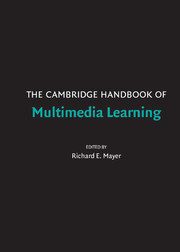Book contents
- Frontmatter
- Contents
- Preface
- Contributors
- 1 Introduction to Multimedia Learning
- PART I THEORETICAL FOUNDATIONS
- PART II BASIC PRINCIPLES OF MULTIMEDIA LEARNING
- 6 Five Common but Questionable Principles of Multimedia Learning
- 7 The Multimedia Principle
- 8 The Split-Attention Principle in Multimedia Learning
- 9 The Modality Principle in Multimedia Learning
- 10 The Redundancy Principle in Multimedia Learning
- 11 Principles for Managing Essential Processing in Multimedia Learning : Segmenting, Pretraining, and Modality Principles
- 12 Principles for Reducing Extraneous Processing in Multimedia Learning : Coherence, Signaling, Redundancy, Spatial Contiguity, and Temporal Contiguity Principles
- 13 Principles of Multimedia Learning Based on Social Cues : Personalization, Voice, and Image Principles
- PART III ADVANCED PRINCIPLES OF MULTIMEDIA LEARNING
- PART IV MULTIMEDIA LEARNING IN CONTENT AREAS
- PART V MULTIMEDIA LEARNING IN ADVANCED COMPUTER-BASED CONTEXTS
- Author Index
- Subject Index
- References
7 - The Multimedia Principle
Published online by Cambridge University Press: 05 June 2012
- Frontmatter
- Contents
- Preface
- Contributors
- 1 Introduction to Multimedia Learning
- PART I THEORETICAL FOUNDATIONS
- PART II BASIC PRINCIPLES OF MULTIMEDIA LEARNING
- 6 Five Common but Questionable Principles of Multimedia Learning
- 7 The Multimedia Principle
- 8 The Split-Attention Principle in Multimedia Learning
- 9 The Modality Principle in Multimedia Learning
- 10 The Redundancy Principle in Multimedia Learning
- 11 Principles for Managing Essential Processing in Multimedia Learning : Segmenting, Pretraining, and Modality Principles
- 12 Principles for Reducing Extraneous Processing in Multimedia Learning : Coherence, Signaling, Redundancy, Spatial Contiguity, and Temporal Contiguity Principles
- 13 Principles of Multimedia Learning Based on Social Cues : Personalization, Voice, and Image Principles
- PART III ADVANCED PRINCIPLES OF MULTIMEDIA LEARNING
- PART IV MULTIMEDIA LEARNING IN CONTENT AREAS
- PART V MULTIMEDIA LEARNING IN ADVANCED COMPUTER-BASED CONTEXTS
- Author Index
- Subject Index
- References
Summary
Abstract
The multimedia principle states that people learn better from words and pictures than from words alone. It is supported by empirically derived theory suggesting that words and images evoke different conceptual processes and that perception and learning are active, constructive processes. It is further supported by research studies that have found superior retention and transfer of learning from words augmented by pictures compared to words presented alone and superior transfer when narration is accompanied by animation compared to narration or animation presented alone. Research has also found that the effectiveness of combining imagery with text varies with the content to be learned, the conditions under which performance is measured, and individual differences in spatial ability, prior knowledge, and general learning ability. Cognitive theory derived from these findings posits interactions between three stages of memory – sensory, working, and long term – that are connected by cooperative, additive channels used to process information arriving from different sensory modalities.
The Multimedia Principle
It is commonly assumed that adding pictures to words, rather than presenting text alone, makes it easier for people to understand and learn. The proverb that a picture is worth a thousand words attests to the popularity and acceptance of this assumption. The assumption leads to what may be called the multimedia principle. This principle, as stated by Mayer (2001), is that people learn better from words and pictures than from words alone, or, more specifically, that people learn more or more deeply when appropriate pictures are added to text (Mayer, in press).
- Type
- Chapter
- Information
- The Cambridge Handbook of Multimedia Learning , pp. 117 - 134Publisher: Cambridge University PressPrint publication year: 2005
References
- 105
- Cited by

